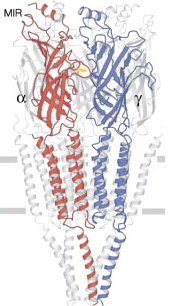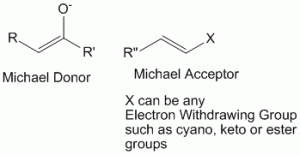Pharmacodynamics is how the drugs acts on the body. More the amount of drug the more intense is the drug action. The mode of action of the drug is the action at the cellular or molecular level. The therapeutic action is the end result of the drug action.
A. Drug – Receptor Action
A receptor is what the drug binds to, to cause a reaction or effect. If the drug fits exactly into the receptor then an excellent drug response results. It is these receptors that are responsible for the normal functioning of the body.

The enzyme converts the substrate into a product without interference. If a competitive drug is present then it will compete with the substrate for the active center of the enzyme. If the drug binds then it will not allow the substrate to bind, then the drug leaves the active center and this allows another drug molecule to bind or the substrate. In this case the enzyme is still active and enzyme action is much slower. E.g. Sulphonamides which are look alike of 4 benzoic acid used in the synthesis of folic acid.
In the case a non–competitive drug binds to the enzyme it will block any further activity. It causes a change in the 3D shape of the enzyme as the drug could have been bound to the remote site instead of the active site, since the shape of the enzyme would have changed it prevents any binding of the substrate.e.g. asprin or some MAOI Drugs that bind to a receptor and produce a biochemical or physiological change in the cell are called agonists, they mimic the substance in our body that would have actually bound to the receptor. E.g. Insulin.
Drugs that bind to a receptor but do not produce a biochemical or physiological change are called antagonist. These drugs block or stop what normally binds to a receptor. E.g. Narcan, as an antidote to a narcotic overdose. On binding to the receptor it does not produce a physiological response and does not allow morphine or heroin to bind to the receptor to stimulate a physiological response.
The receptor site can be a part of the cell and on the surface of the cell Or it can be within the cell (Intracellular), or it could even just be floating in the blood (like the coagulation enzymes).
Receptor is usually a protein. Partial agonists: when a transmitter binds to a receptor, bonding occurs between the drug and the receptor. There has to be complete congruity between the drug and the receptor for the reaction to proceed. This is known as a receptor fit. Some drugs do not fit exactly on the receptor and hence they stimulate a response but not as much as the natural receptor fit and this is termed as a partial agonist.
Agonist and Antagonist Drugs
Some drugs act as both agonist to one receptor and antagonist to another receptor. E.g. pentazocine which is a narcotic opioid. It will bind to one receptor and displace morphine and bind to other receptor associated with pain and produce an agonist effect by stimulating them.
Drug Receptors
- Membrane solubility allows lipid soluble drugs to cross the cell membrane and bind to intracellular receptors e.g. NSAIDS, NRTI ( nucleotide analogue reverse transcriptase inhibitor) MAOI
- Transmembrane proteins bind the drug at the extracellular site and binding activates an intracellular enzyme site e.g. Insulin
- Transmembrane protein is linked to an enzyme via a G – protein e.g. Opioid drugs
- The receptor is a transmembrane ion channel. E.g. Calcium channel blocker. The receptor can be located at several places in the body and this is what leads to producing side effects.
B. Direct Physiological Action
- Chemical reaction: drugs work by simple chemical reactions. E.g. antacids, chelating agents.
- Physical action: by some kind of physical mechanism e.g. osmosis, flatulence.
Drug Interaction
A drug interaction is the phenomenon in which a substance or an external circumstance affects the action of the drug.
Interactions outside the body such as sunlight, moisture, reaction with the so called inert filler material, reaction with the containers, or mixing of a drug in a syringe can cause a so called chemical reaction and lead to decreased drug action.
Within the body, the drug may undergo interactions with many factors such as:
Interaction in the Gastrointestinal Tract
The amount of drug absorbed from the gastrointestinal (GI) tract determines the blood plasma level of the drug better known as bioavailability. If the bioavailability is reduced it will lead to the fact that the drug cannot achieve its mec and as a result there will be decreased therapeutic effect. Sometimes the converse is also true. E.g. tetracycline taken with calcium compounds has decreased bioavailability. Iron is better absorbed as ferrous then ferric and hence should be taken with an antioxidant like vit C. Some drugs prevent the absorption of other fat soluble vitamins leading to a deficiency. There can also be interaction between the drug and food which may not be favorable.
Interactions after Absorption
Usually occurs when drugs are administered concurrently. Many of these interactions between the drugs and the enzyme of the liver can alter the amount of time the drug is present in the system.
Some drug interactions can prove to be beneficial and is known as synergism : two types: additional or summation and potentiation.
Liver enzyme and drug interaction: Inside the liver cells there are vesicles called microsomes which contain the relevant enzyme for metabolism. Cytochrome P450 has many isoforms. An isoform is when there is the same enzyme with a small change in its structure which makes it have different substrate specificity.
Drug–Drug Interaction
Drug A can intensify the effect of drug B = Potentiation = increased therapeutic effect or an increase in the adverse reaction.
Drug A inhibits the effect of drug B = Inhibitoy = reduced therapeutic effect or reduced adverse reaction.
Food Drug interaction
A drug molecule can interact with food ingested at the same time. This can decrease the rate of absorption, or even increase drug toxicity. Timing of administration of drug with food is often important. For e.g. tetracycline gets inactivated with calcium and therefore it is advisable not to take tetracycline with calcium-rich foods such as milk.
Affinity, Specificity, Efficacy, Potency
Affinity: is defined as the extent of binding of a drug to a receptor, the greater the affinity the more the binding and consequently more the action
Specificity: defined as the ability of the drug to produce an action at the specific site
Efficacy: is the ability of the drug to produce an effect at the receptor
Potency: is defined as the relative amount of drug that has to be present to produce a desired effect. The more potent a drug the lesser it has to be administered.
Factors Affecting Drug Response
- Age: either very young or very old may not be able to process the drug efficiently.
- Gender: different body compositions and the amt of fat to lean tissue can influence the action of drugs as well as its passage through the body.
- Body weight: Increased body weight might lead to an increased amount of drug that needs to be taken to achieve the same response.
- Body surface area: determined by the use of a nomogram.
- Basal Metabolic rate: high BMR: rapid metabolism and elimination of the drug.
- Genetic factors: differences in the genetic composition of the different patients. E.g. fast and slow acetylators.
- Placebo effect: Placebo = dosage that contains no pharmacologicaly active ingredient. Placebo effect = effect elicited by administration of virtually any drug whether it is pharmacologically active or not.
- Tolerance
- Pathological status : disease. GI Tract illness will affect oral medicines whereas parental absorption of drugs can be affected by a circulatory shock, peripheral vascular illness and cardiac failure.
- Drug interaction. Different drug interaction may affect the absorption, metabolism, distribution and elimination of the drug.
- Habits
- Effects of exercise.
- Effects of diet: food in the gut will prove to be competition for the drug and hence the amount of drug would actually be lowered. Lipid soluble drugs are less affected as compared to water soluble drugs. The activity of the microsomal enzyme cytochrome P450 depends on the amount of minerals and vitamins present. It needs vitamins A, B1 and B2 , essential fatty acids, proteins and minerals like copper, zinc and calcium for proper functioning. If there is an imbalance in any of the above there is an imbalance in the activity of the enzyme.
- Effects of pregnancy.
References
- Goodman & Gilman’s The Pharmacological Basis of Therapeutics by. Joel Griffith Hardman, Lee E. Limbird, Alfred G. Gilman. 10th Ed.
- Rang & Dale’s Pharmacology by. Humphrey Rang, Maureen Dale, James Ritter, Rod Flower. 6th Ed.
- Unwin, N. Refined structure of the nicotinic acetylcholine receptor at 4A resolution. J Mol Biol 346: 967–989, 2005



marvellous information………………..